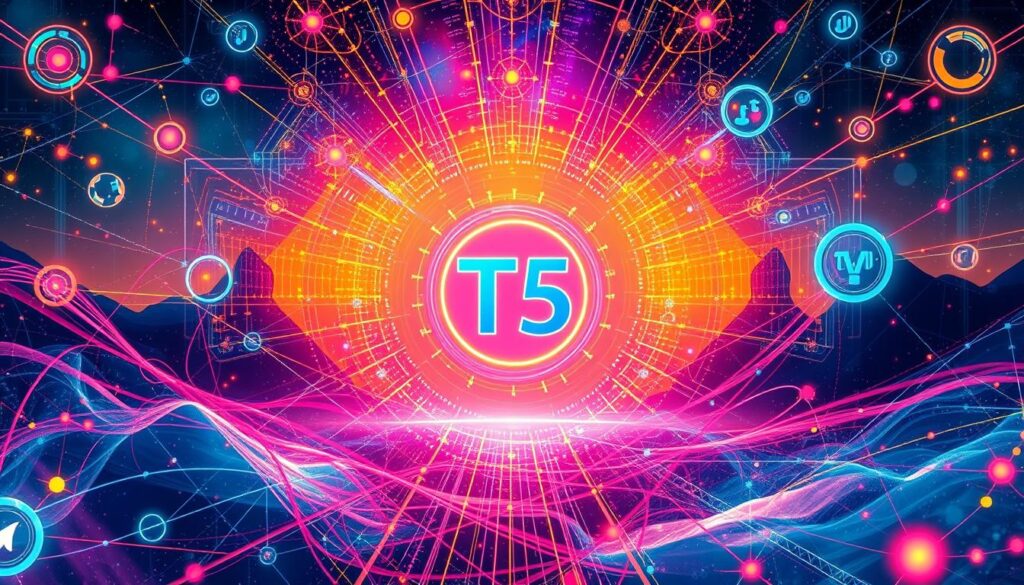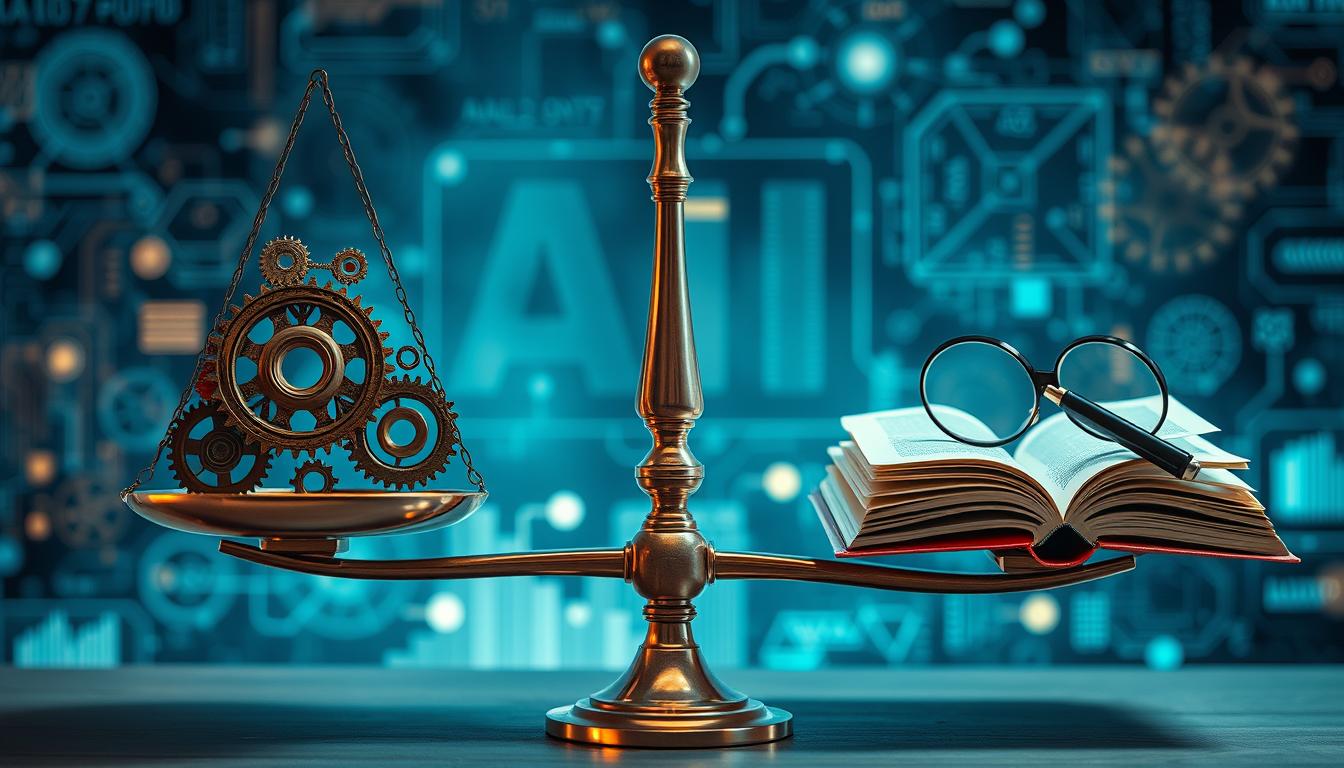For 60 years, making machines talk like humans was a big challenge. But now, thanks to GPT, BERT, and T5, we’ve made huge progress. These models can understand and create human-like language. They’re used in many areas, like translating languages and making chatbots.
ChatGPT and other large language models are seen very differently by experts and the public. While some, like Chomsky, have doubts, many people love using ChatGPT. At Capital One, they’re focusing on making AI better for their work, showing how important these models are1.
These advanced language models are helping create smarter AI. They’re being used to make AI that’s better at specific tasks, not just general things1.
Key Takeaways
- State-of-the-art language models such as GPT, BERT, and T5 have revolutionized the field of natural language processing.
- These models have been widely adopted in various applications, including language translation, text summarization, and chatbots.
- The effectiveness of Llama 3 and open-weight models is highlighted, stressing their growing use in big business.
- State-of-the-art language models are being used to develop more advanced AI agents, with a focus on task-specific models versus general-purpose models.
- Automated Reasoning Checks by AWS provide safeguards against LLM hallucinations, showing a push for more reliable AI outputs1.
- Reinforcement learning techniques are used as a safeguard for the platform’s consumer product nature, addressing the public’s mixed reception of the model’s outputs based on ethical standpoints2.
Understanding State-of-the-Art Language Models: GPT, BERT, T5
The world of language models has seen big changes, moving from old statistical models to new transformer-based ones3. Natural Language Processing (NLP) is growing fast, aiming to understand, analyze, and create human language3. Models like GPT, BERT, and T5 have changed NLP, making it possible to create models that work well for different tasks.
Modern NLP focuses on context, attention, and transformers4. The transformer architecture is key to many top language models. It works well in tasks like analyzing feelings, translating languages, and creating dialogues5. BERT and GPT-3 are examples of these models, with BERT leading in NLP benchmarks and GPT-3 being huge with 175 billion parameters5.
Here are some stats on these models’ performance:
- BERT model accuracy: 0.908 (90.8%)3
- GPT model accuracy: 0.853 (85.3%)3
- T5 model accuracy: 0.810 (81.0%)3
These numbers show how well these models do, with BERT leading the pack3. Using ai models, advanced language models, and nlp frameworks is key to making these models work well.
For more on how these models are used, check out this link. It shares success stories from top brands using these models4.
GPT (Generative Pre-trained Transformer) Architecture Deep Dive
The GPT architecture is based on transformer models. These models have led to top results in natural language processing tasks6. The first GPT model was released in June 20186. It has seen improvements, with GPT-2 in February 2019 and GPT-3 in May 2020. These models can do tasks without needing to be fine-tuned, thanks to zero-shot learning6.
The GPT architecture includes self-attention mechanisms and multi-head attention. It also uses positional encoding. These features help the model understand the context and generate natural-sounding text. The GPT model is used in text generation, language translation, and summarization. Research shows it has led to top results in many NLP tasks, making it a favorite among experts.
The following table summarizes the key features of the GPT architecture:
| Model | Release Date | Parameters |
|---|---|---|
| GPT | June 2018 | 117 million |
| GPT-2 | February 2019 | 1.5 billion |
| GPT-3 | May 2020 | 175 billion |
The GPT architecture is widely used in text generation and language translation. It has achieved top results in many NLP tasks7. The transformer models, including GPT, are known for handling large datasets well. They offer superior performance in NLP tasks, making them a top choice for researchers and developers.
BERT Model: Bidirectional Encoding Innovations
The BERT model has brought big changes to language modeling. It uses masked language learning and next sentence prediction. These methods have made BERT better at understanding language8.
One key part of BERT is its masked language model. It hides some words and guesses them back based on the text8. This method has helped BERT do well in tasks like answering questions and figuring out sentiment9.
BERT is great at many NLP tasks. It’s good at answering questions, understanding feelings, and classifying text9. Its ability to look at both sides of the text makes it very useful.
Some benefits of BERT include:
- Improved performance in NLP tasks
- Ability to capture bidirectional contexts
- Effective use of masked language learning and next sentence prediction
BERT is a top tool for NLP tasks. Its new ideas in language modeling have made it very good at many tasks8. As a next-gen language model, BERT is leading the way for more progress in NLP.
For more information on the BERT model, you can visit the Wikipedia page on BERT.
| Model | Parameters | Accuracy |
|---|---|---|
| BERT_large | 345 million | Improved performance in NLP tasks8 |
| BERT_base | 110 million | Improved accuracy on MNLI task8 |
T5: Text-to-Text Transfer Transformer Framework
The T5 framework is a top-notch language model. It uses a text-to-text format for all NLP tasks10. This model has shown great results in machine translation, even better than models made just for translation10. It was trained on the Colossal Clean Crawled Corpus (C4), a huge text dataset over 750 GB10.
The T5 framework is at the forefront of language technology. It can handle many NLP tasks in one way10. It uses a sequence-to-sequence framework, making it flexible for text, code, and tables10. T5 can create various texts, like poems and emails, showing great creativity and fluency10.
Some key features of the T5 framework include:
- Pre-training on a large dataset, such as the C4 corpus, which requires significant computational resources11
- Fine-tuning on specific tasks, such as machine translation or text summarization11
- Use of a unified text-to-text format for pre-training and fine-tuning, which yields significant performance improvements12
The T5 framework has set new records in many NLP tasks. It excels in machine translation, text summarization, and question answering10. It can also work with different formats, making it a versatile tool for NLP10.

For more information on the T5 framework, visit this link. Learn about the latest in language technology and advanced models like T5.
Practical Applications and Industry Impact
State-of-the-art language models are changing many industries. They help with customer service, language translation, and text summarization13. These models make businesses more efficient and improve customer service. For example, Google and Microsoft use them to create chatbots and virtual assistants.
Using these models in businesses needs a good plan. You must pick the right model, train it, and fit it into your systems. A study shows that using pre-trained models can save time and money14. They also help in finance and healthcare by making data insights more accurate15.
These models offer better accuracy, efficiency, and customer service. They can automate tasks like data analysis and language translation. But, they need a lot of power, data, and skilled people13. There are also worries about bias and fairness, which need careful testing15.
In conclusion, these models are changing many industries. They are making businesses better in many ways. To learn more, visit this link for a detailed analysis.
| Model | Parameters | Release Year |
|---|---|---|
| GPT-2 | 1.5 billion | 2019 |
| GPT-3 | 175 billion | 2020 |
| Jurassic-1 | 178 billion | 2021 |
Conclusion: The Future of Language Models
The future of language models is bright, with new research and tech on the horizon16. Models like GPT-3 have been trained on huge amounts of text, showing their power17. Models from 2018, like BERT, and newer ones, like T5, have already improved a lot in understanding and creating text.
Looking ahead, we’ll see even more advanced models. They’ll use the latest in deep learning and natural language processing. These models will handle many tasks, from translating languages to summarizing texts. They’ll change how we interact with technology and each other, improving customer service and content creation.
The future of language models is exciting and full of possibilities17. As we explore new limits, we’ll see big steps forward. This will lead to new ways to use language technology in our lives and work.
FAQ
What are state-of-the-art language models and how do they impact natural language processing tasks?
How do transformer models, like GPT and BERT, differ from traditional language models?
What is the core principle of modern NLP, and how do models like BERT and T5 embody this principle?
How does the T5 framework differ from other language models, and what are its advantages?
What are the practical applications of state-of-the-art language models in enterprise settings, and how can they be implemented effectively?
Source Links
- The TWIML AI Podcast (formerly This Week in Machine Learning & Artificial Intelligence) – Podcast | Global Player – https://www.globalplayer.com/podcasts/42KobX/
- The False Promise of Chomskyism – https://scottaaronson.blog/?p=7094
- Building State-of-the-Art NLP Applications with GPT, BERT, and T5: A Practical Tutorial – https://ai.plainenglish.io/building-state-of-the-art-nlp-applications-with-gpt-bert-and-t5-a-practical-tutorial-9a580d694249
- What is BERT, GPT, and Related Models – https://www.activeloop.ai/resources/glossary/bert-gpt-and-related-models/
- A Structured Guide to Understanding Large Language Models (LLMs) – https://www.linkedin.com/pulse/structured-guide-understanding-large-language-models-llms-chauhan-utskc
- How do Transformers work? – Hugging Face NLP Course – https://huggingface.co/learn/nlp-course/chapter1/4
- How Transformer Models Work – https://botpenguin.com/blogs/how-transformer-models-work
- BERT Explained: State of the art language model for NLP – https://towardsdatascience.com/bert-explained-state-of-the-art-language-model-for-nlp-f8b21a9b6270
- NLP Rise with Transformer Models | A Comprehensive Analysis of T5, BERT, and GPT – https://www.unite.ai/nlp-rise-with-transformer-models-a-comprehensive-analysis-of-t5-bert-and-gpt/
- Demystifying T5: A Dive into the Text-to-Text Transfer Transformer – https://medium.com/@shwethashwe1144/demystifying-t5-a-dive-into-the-text-to-text-transfer-transformer-acd278547ed8
- T5: Text-To-Text Transfer Transformer – https://github.com/google-research/text-to-text-transfer-transformer
- T5: Text-to-Text Transformers (Part Two) – https://cameronrwolfe.substack.com/p/t5-text-to-text-transformers-part-354
- Introduction to Large Language Models (LLMs): An Overview of BERT, GPT, and Other Popular Models – https://www.johnsnowlabs.com/introduction-to-large-language-models-llms-an-overview-of-bert-gpt-and-other-popular-models/
- A Comprehensive Guide to Large Language Model Applications with Hugging Face – https://medium.com/@nimritakoul01/a-comprehensive-guide-to-large-language-model-applications-with-hugging-face-7da9085c0c19
- The Integration of Large Language Models in Enterprises: Revolution or Evolution? – https://blog.ptidej.net/the-integration-of-large-language-models-in-enterprises-revolution-or-evolution/
- A Comparative Analysis of LLMs like BERT, BART, and T5 – https://medium.com/@zaiinn440/a-comparative-analysis-of-llms-like-bert-bart-and-t5-a4a873251ff
- Transformer, GPT-3,GPT-J, T5 and BERT. – https://aliissa99.medium.com/transformer-gpt-3-gpt-j-t5-and-bert-4cf8915dd86f










